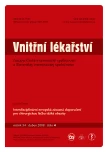-
Medical journals
- Career
Pericardiocentesis after cardiac surgery – our experience
Authors: M. Kolek; R. Brát
Authors‘ workplace: Kardiochirurgické centrum FN Ostrava, prim. MUDr. Radim Brát, Ph. D.
Published in: Vnitř Lék 2008; 54(4): 334-340
Category: Original Contributions
Overview
Pericardial effusion after cardiac surgery is common, but only in a small part of patients it has progressive character and cardiac tamponade occurs. Accurate diagnosis and well-timed pericardiocentesis are necessary to effective management of this life threatening complication. The study aimed at presentation of our centre outcomes of echocardiographically-guided pericardiocentesis in patients after cardiac surgery.
Methods:
Between December 2005 and November 2007, 2,232 patients underwent open-heart surgery in our centre. At 48 (2.2%) of them pericardiocentesis for clinically significant pericardial effusion was performed.Results:
Pericardiocentesis was significantly more frequent after valve surgery (7.1%, p < 0.001), aortic root surgery (8.2%, p < 0.001) and surgical ablation of atrial fibrillation (6.6%, p < 0.001), i.e. in patients who had received postoperative anticoagulation therapy. Echo-guided pericardiocentesis was technically and therapeutically successful in 100% of cases and no complications were registered. The time elapsed between surgery and puncture was in range 6 to 80 days (median, 13 days). The median volume initially aspirated was 450 ml (range, 50 to 1,550 ml). Forty five patients (93.8%) had extended catheter drainage with active suction, the median duration of the drainage was 1 day (range, 1 to 6 days), the mean volume of catheter drainage was 328 ml (median, 145 ml; range, 20 to 2,950 ml). Four patients (8.3%) required repeated pericardiocenteses because of recurrence of significant pericadial effusion. Extended pericardial catheter drainage (after initial evacuation of the effusion) was associated with a significant reduction of recurrence of significant pericadial effusion and with lower probability of repeated pericardiocentesis.
We can conclude, echo-guided pericardiocentesis was effective and safe method for primary treatment of postoperative pericardial effusions.Key words:
pericardial effusion – cardiac tamponade – pericardiocentesis – echocardiography – cardiac surgery
Sources
1. Ikaheimo MJ, Huikuri HV, Airaksinen KE et al. Pericardial effusion after cardiac surgery: incidence, relation to the type of surgery, antithrombotic therapy, and early coronary bypass graft patency. Am Heart J 1988; 116 : 97–102.
2. Pepi M, Muratori M, Barbier P et al. Pericardial effusion after cardiac surgery: incidence, site, size, and haemodynamic consequences. Br Heart J 1994; 72 : 327–331.
3. Meurin P, Weber H, Renaud N et al. Evolution of the postoperative pericardial effusion after day 15: the problem of the late tamponade. Chest 2004; 125 : 2182–2187.
4. Tsang TS, Barnes ME, Hayes SN et al. Clinical and echocardiographic characteristics of significant pericardial effusions following cardiothoracic surgery and outcomes of echo-guided pericardiocentesis for management: Mayo Clinic experience, 1979–1998. Chest 1999; 116 : 322–331.
5. Suehiro S, Kimura E, Shibata T et al. Late pericardial effusion after open-heart surgery: usefulness of pericardiocentesis under echocardiographic guidance. Kyobu Geka 1996; 49 : 105–110.
6. Tsang TS, Oh JK, Seward JB et al. Diagnostic value of echocardiography in cardiac tamponade. Herz 2000; 25 : 734–740.
7. Mangi AA, Palacios IF, Torchiana DF. Catheter pericardiocentesis for delayed tamponade after cardiac valve operation. Ann Thorac Surg 2002; 73 : 1479–1483.
8. Lindenberger M, Kjellberg M, Karlsson E et al. Pericardiocentesis guided by 2-D echocardiography: the method of choice for treatment of pericardial effusion. J Intern Med 2003; 253 : 411–417.
9. Malouf JF, Alam S, Gharzeddine W et al. The role of anticoagulation in the development of pericardial effusion and late tamponade after cardiac surgery. Eur Heart J 1993; 14 : 1451–1457.
10. Alkhulaifi AM, Speechly-Dick ME, Swanton RH et al. The incidence of significant pericardial effusion and tamponade following major aortic root surgery. J Cardiovasc Surg (Torino) 1996; 37 : 385–389.
11. Susini G, Pepi M, Sisillo E et al. Percutaneous pericardiocentesis versus subxiphoid pericardiotomy in cardiac tamponade due to postoperative pericardial effusion. J Cardiothorac Vasc Anesth 1993; 7 : 178–183.
Labels
Diabetology Endocrinology Internal medicine
Article was published inInternal Medicine

2008 Issue 4-
All articles in this issue
- Pericardiocentesis after cardiac surgery – our experience
- Higher incidence of thyropathy in patients with oesophageal achalasia. Genetic, autoimmune, regional or just a random association?
- Possibilities of evaluation of changes of glomerular filtration rate estimated on the basis of predicting formulas
- Traditional risk factors of atherosclerosis in patients with obstructive sleep apnoe-hypopnoe syndrome
- Results of the PREDICTIVE project in the Czech Republic
- Pathogenesis of insulin resistance in different endocrinopathies
- Exenatid and its position as antidiabetic drug in the treatment of type 2 diabetes mellitus
- Hypoglycaemia
- The importance of determining the viability of the myocardium prior to revascularisation in patients with ischaemic cardiomyopathy and left ventricular systolic dysfunction
- Human leukocyte differentiation antigens and CD classification
- ECG changes in alcoholic intoxication
- Preparation of patients with haemostasis disorder for dental surgery
- Lyme carditis – rare cause of dilated cardiomyopathy and rhythm disturbances
- Internal Medicine
- Journal archive
- Current issue
- Online only
- About the journal
Most read in this issue- Pericardiocentesis after cardiac surgery – our experience
- Lyme carditis – rare cause of dilated cardiomyopathy and rhythm disturbances
- ECG changes in alcoholic intoxication
- Human leukocyte differentiation antigens and CD classification
Login#ADS_BOTTOM_SCRIPTS#Forgotten passwordEnter the email address that you registered with. We will send you instructions on how to set a new password.
- Career

